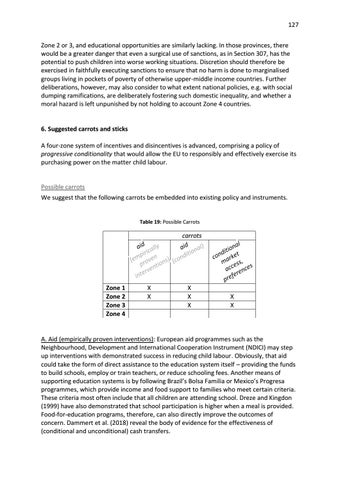127 Zone 2 or 3, and educational opportunities are similarly lacking. In those provinces, there would be a greater danger that even a surgical use of sanctions, as in Section 307, has the potential to push children into worse working situations. Discretion should therefore be exercised in faithfully executing sanctions to ensure that no harm is done to marginalised groups living in pockets of poverty of otherwise upper-middle income countries. Further deliberations, however, may also consider to what extent national policies, e.g. with social dumping ramifications, are deliberately fostering such domestic inequality, and whether a moral hazard is left unpunished by not holding to account Zone 4 countries.
6. Suggested carrots and sticks A four-zone system of incentives and disincentives is advanced, comprising a policy of progressive conditionality that would allow the EU to responsibly and effectively exercise its purchasing power on the matter child labour.
Possible carrots We suggest that the following carrots be embedded into existing policy and instruments.
Table 19: Possible Carrots
carrots
Zone 1 Zone 2 Zone 3 Zone 4
X X
X X X
X X
A. Aid (empirically proven interventions): European aid programmes such as the Neighbourhood, Development and International Cooperation Instrument (NDICI) may step up interventions with demonstrated success in reducing child labour. Obviously, that aid could take the form of direct assistance to the education system itself – providing the funds to build schools, employ or train teachers, or reduce schooling fees. Another means of supporting education systems is by following Brazil’s Bolsa Familia or Mexico’s Progresa programmes, which provide income and food support to families who meet certain criteria. These criteria most often include that all children are attending school. Dreze and Kingdon (1999) have also demonstrated that school participation is higher when a meal is provided. Food-for-education programs, therefore, can also directly improve the outcomes of concern. Dammert et al. (2018) reveal the body of evidence for the effectiveness of (conditional and unconditional) cash transfers.













